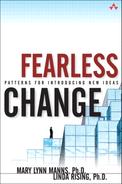Just Enough
Most of us have had the kind of teacher who knows so much about a certain topic that he feels compelled to tell his students all about it as fast as he can. He doesn’t seem to notice the blank stares—he just keeps talking and his students just keep staring.
To ease learners into the more difficult concepts of a new idea, give a brief introduction and then make more information available when they are ready.
![]()
You are an Evangelist(144) or Dedicated Champion(129) working to spread the word about a new idea in your organization.
Difficult, complex concepts can overwhelm novices.
All new ideas involve a learning curve. Some of the new things people will have to face are complex and cannot be understood in a short time. Although learners should understand the challenging concepts at some point so they can use the innovation effectively, giving a thorough explanation of such concepts while you are covering the basics can be confusing. This may cause learners to think the innovation is too complicated. It may discourage busy people from taking the time to learn more.
A slow but sure introduction to a new idea can be compared to Christopher Alexander’s Gradual Stiffening pattern. He recommends that, when creating a complex building structure, one should “…build a building in such a way that it starts out loose and flimsy while final adaptations in plan are made, and then gets stiffened gradually during the process of construction, so that each additional act of construction makes the structure sounder.”[*]
Each new concept that is taught to learners should allow their comprehension to become sounder. If you introduce too much of a good thing too fast you may overwhelm your learners and, at the same time, reduce your flexibility and increase your costs.
Therefore:
When introducing the new idea, concentrate on the fundamentals and give learners a brief description of the more difficult concepts. Provide more information when they are ready.
If you are doing a presentation to introduce the new idea, include more advanced concepts in a slide or two. If you are having an informal discussion, give learners the information they can comfortably handle and let them know that there is more to learn. Provide enough to start interested individuals on an investigation of their own.
When giving a presentation to high-level management, give the conclusions first. Paint the big picture and explain the details only if you’re asked. Stress the gains rather than the losses. Emphasize the wins without stretching the truth or ignoring the risks.
Even though you shouldn’t overwhelm learners with too many details, you want to offer the encouragement and resources they need to consider more when they have experience. Provide URLs or a list of references. Make yourself available to answer questions. Use Personal Touch(198) to show how the innovation can be useful in their jobs.
After learners have had time to understand the basics, find opportunities for a more in-depth discussion. This will allow them to develop confidence about what they’ve learned, which is likely to spark their interest in learning more.
= = = = = = = = =
This pattern initiates a slow but sure understanding of difficult topics. This approach also keeps change leaders from hyping the innovation as a perfect and complete solution from the beginning.
But what works for some people will not necessarily work for others. At one extreme, there may be people who won’t comprehend the basics and worry that there are even more difficult concepts to come. At the other extreme, there will be people who want to know more and may feel that you don’t think they’re smart enough to handle the advanced concepts. Keep lines of communication open with everyone so they are comfortable asking questions to get the amount of information they desire.
When Janet introduces patterns during her tutorials, the difficult concepts such as QWAN and generativity are mentioned as important but are not covered in detail. Instead, attendees are pointed to Christopher Alexander’s book, The Timeless Way of Building, if learners wish to read more. Janet always reminds students that she is available to answer questions when they are ready.
When moving from CMM (Capability Maturity Model) Level 1 to Levels 2 and 3, the process introductions were synched with the development cycle. Rather than trying to give the team all the process changes at the beginning, “just enough” of the process changes were introduced to get through the next stage.
